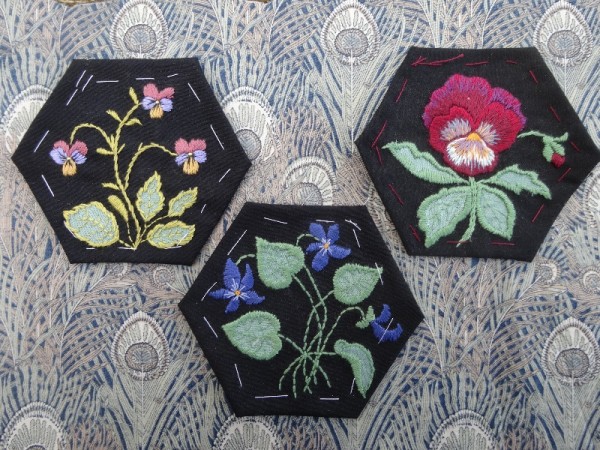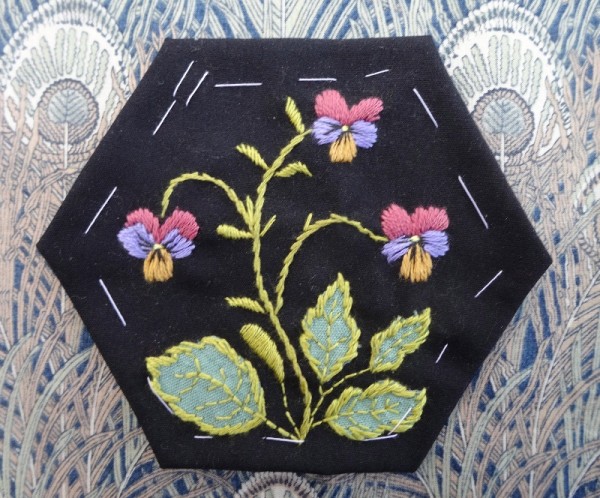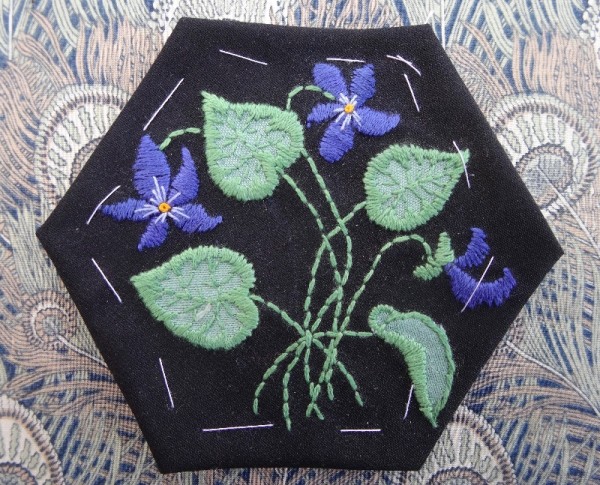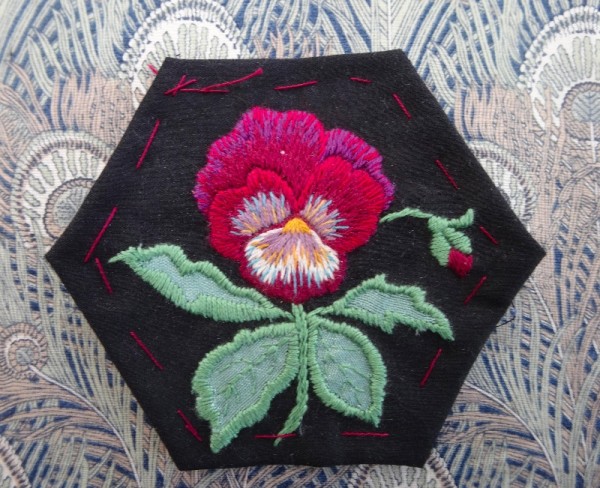A few more flowers for the patchwork altar frontal.*
All three of these related plants grow happily locally and the violet in particular has made itself very at home around the large tree at the entrance to Ipsden churchyard. Both the violet (Viola reichenbachiana/ the early dog violet shown here) and heartsease (Viola tricolor) are true wild flowers while the multicoloured garden pansy (Viola tricolor var. hortensis) is the result of complex hybridisation involving at least 3 species in the section Melanium, one of which is the heartsease. Modern pansies are often distinctive for the well defined ‘blotch’, a spectacular black eye in the middle of the flower. There is also some difference in the way the petals point up or down. Pansies in the Viola sect. Melanium are supposed to have 4 petals pointing up and only one down whereas the violets in the Viola sect. Viola have 2 up and 3 down (error, err, artistic licence permitting). Botanical lesson over.
My mother’s name was Violet which I loved, although it was usually shortened to Vi which I wasn’t so keen on when I was little but which I’ve softened toward over the years – it now sounds quite dashingly innocent, like an Angela Brazil healthy hearty schoolgirl weaving her way up and down a netball or lacrosse pitch.
There have been some wonderful literary Violets.
There’s Violet Effingham in Anthony Trollope’s Phineas Finn. Orphan, heiress, beauty, she’s one of those excellent women (feisty and mischievous too) who turns down the hero, Phineas, and (finally) marries the rogue man she’s always loved. Miraculously – through the love of a good woman undoubtedly – her beloved settles down to become a good husband and an exemplary gentleman … oh and makes her Lady Chiltern into the bargain.
Still with the (fictional) aristocracy is Lady Violet Crawley, the Dowager Countess of Grantham, a redoubtable character whose sayings have spawned a Pinterest board solely in their honour (and thus Pinterest shows itself capable of being a sort of everyman’s Oxford Dictionary of Quotations). Of Branson, her grandson-in-law (and former chauffeur), she says, “If we can show the county that he can behave normally they will soon lose interest in him. And I shall make sure he behaves normally because I shall hold his hand on a radiator until he does.” Advice we may or may not want to follow.
Then who knew that Somerville and Ross – who jointly wrote those wonderful Irish RM books – when unpacked are revealed to be Edith Somerville and Violet Florence Martin, the latter writing under the name of Martin Ross? (Active as a contestant in our local village quiz league, I like to tuck these snippets back, though I can see that others may not find this interesting at all). Note to self to scour the library catalogue for the wonderfully funny and warm TV adaptation of the books shown on televison about 20 years ago.
Even more dashing was Violet Trefusis, lover of Vita Sackville West. Not only did their affair feature in their own fiction but it was borrowed by Virginia Woolf and used in her time travelling novel Orlando where, thinly disguised, the relationship achieved further notoriety. Nancy Mitford found Violet equally irresistible and based Lady Montdore on her in Love in a Cold Climate (one of those comfort books I slope off to the boudoir to re-read every so often when only a good laugh, a frothy capuccino and perhaps a few squares of dark milk chocolate will do.) More quiz fodder: Camilla, Duchess of Cornwall and wife of Prince Charles is Violet’s great-niece.
Sadly, Pansy has not had such an uplifting literary pedigree. I’ve recently re-read Henry James’s Portrait of a Lady about which I have completely changed my opinion. When I was younger I found the book, and especially Isabel Archer, interminably irritating and I have spent more than half a life time being rather rude about both the book and the main character. Age and experience have however left me better able to appreciate Isabel’s choices and her commitment to those choices. Particularly touching is her relationship with her young stepdaughter Pansy. Poor Pansy, a decent, docile, obedient daughter to the abominable Gilbert Osmond, has been drip fed lies since birth. When Isabel leaves Gilbert, she finds herself promising Pansy that she will return for her sake. This she does, though we aren’t really sure exactly why nor what her intentions are. Honourable enough to face up to her own mistakes and live with them, you can only be in awe of her – although you do find yourself hoping she’ll just grab Pansy and run back to England where she will not only face social censure full on but grab it by the ears and fight it to the ground. Hmmmmm.
Pansy O’Hara very nearly became a household name, but the Pansy bit was vetoed by the intervention of a canny publisher and Gone with the Wind appeared with the far better named Scarlett O’Hara instead. Just before publication, Margaret Mitchell upon being asked to make the change, wrote to a friend, ” We could call her Garbage O’Hara for all I care, I just want to finish this damn thing.” What a pity she didn’t make the book shorter while she was at it.
At 7a.m this morning I saw a thrush in the vicarage garden – the first for several years.
*For those coming to this website for the first time I should point out that these embroidered flowers are to be part of a patchwork altar frontal being made by the village for Ispden Church. Past posts on this project can be found in one of two ways :
1. Put “altar frontal” in the search box to the right of the main text and then click into each abbreviated text for the full entry. Please note that only 2 entries appear after the search and that after you’ve viewed these you need to scroll down past the two abbreviated entries and click into “older posts”. You will also find a few other altar frontals appearing by this method.
OR
2. Click into the Gallery and click into the relevant photographs as they appear if you want to read the accompanying text.
Sorry this is so long winded, I have yet to make time to index past posts.






12 Comments
Well, I find your snippets interesting – and the embroidery is charming!
Thank you Rachel – you’re always encouraging.
A great read as always, and beautiful embroidery, the black really sets off the jewel colours. Good you saw a thrush, I also have not seen one for years
Very kind of you to say so, Jane.
No second sighting of the thrush as yet.
My granddaughter, now 15 months old, has Pansy as her second name after her maternal great grandmother who died when her own daughter was just 4 years old That daughter is now 87 years old and it must be heartwarming having her mother’s name remembered and celebrated in another generation. My husband sighs when he sees pansies as it reminds him of his own grandmother who loved them. Perhaps it’s their ‘faces’ we look into, but pansies make my heart melt, and your lovely embroidered ones, Mary, are utterly charming.
Celandines and primroses out in force today along the hedgerows but no thrushes. How marvellous when they return to one’s garden. Two long-tailed tits come several times a week to a feeder with fat sticks. They stay just a few thrilling seconds. Blink and they’re gone.
Debbie George: visited an exhibition today of her newest paintings. Some had vintage book covers as well as commemorative mugs with flowers. So very tempting. I could have bought the lot.
Thank you for a wonderful post, Mary. I had to have a break from that cardigan and you’ve lifted my spirits again.
Lovely to hear from you Penny.
Second – or third – names are good for commemorating family members through the generations and your granddaughter is fortunate that her name gives rise to happy thoughts of two different relatives.
Pansies do seem so cheerful and I especially like the slightly smaller versions in a single colour without the central dark blotch. In general at the moment, garden flowers seem a bit slow in coming with the low temperatures, so it must have been uplifting to visit Debbie George’s exhibition.
Push to the end with that knitting!
In Thomas Hardy’s A Pair of Blue Eyes the heroine, Elfriede Swancourt, has a pony called Pansy.
The television series of The Irish RM, which you mention, is wonderful comfort watching. I like the way in which Flurry Knox looks completely at home on a horse, while Major Yeates looks rather stiff and novice.
Pansy is a lovely name for a pony. I recently heard the book abridged for radio, isn’t Swancourt a wonderful name?
I thought all the cast were wonderful in the Irish RM but Bryan Murray as Flurry in particular was a delightful rogue with oodles of charm. I’ve just looked at the Wikipedia entry for the TV series (http://en.wikipedia.org/wiki/The_Irish_R.M.#About_the_TV_series) and am aghast to discover that the house that stood in for the major’s house (Shreelane House) was demolished at the end of the third series to make way for a golf course….!!!!
How sad!
Surely your collection of literary Violets should include Violet Elizabeth Bott?
Of course, how could one leave her out!
I love this little trio – an absolute delight… how wonderful for the congregation to sit and gaze at each little flower – perhaps they will each pick a different flower to contemplate every week…. lovely work Mary….
Thank you, Lydia.
One Trackback
[…] lace like image, quite different from other illustrations in my whitework alphabet. V for violet was equally desirable and has the benefit of having a white form (lots around Ipsden Church) […]